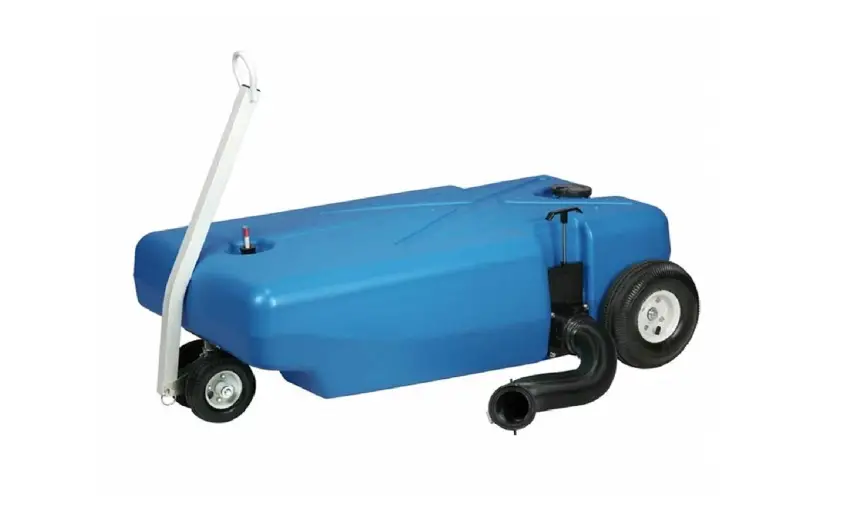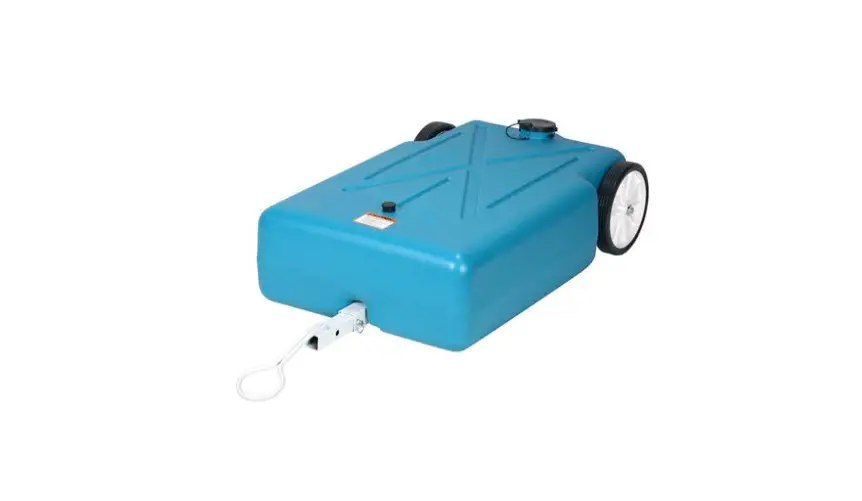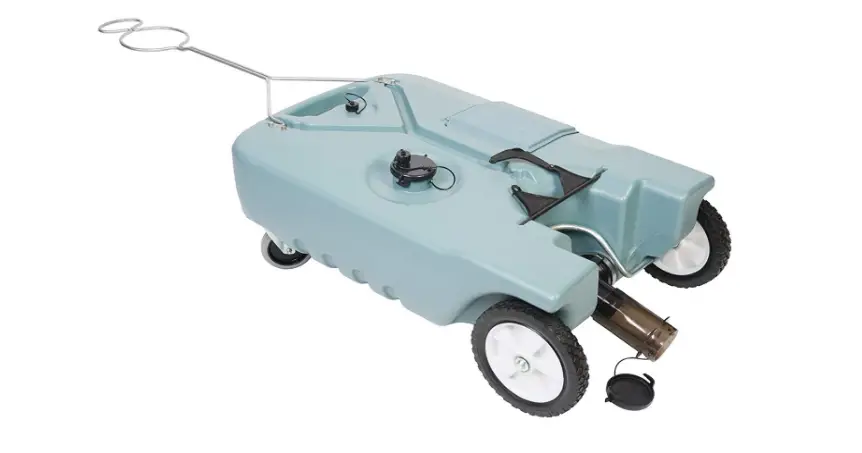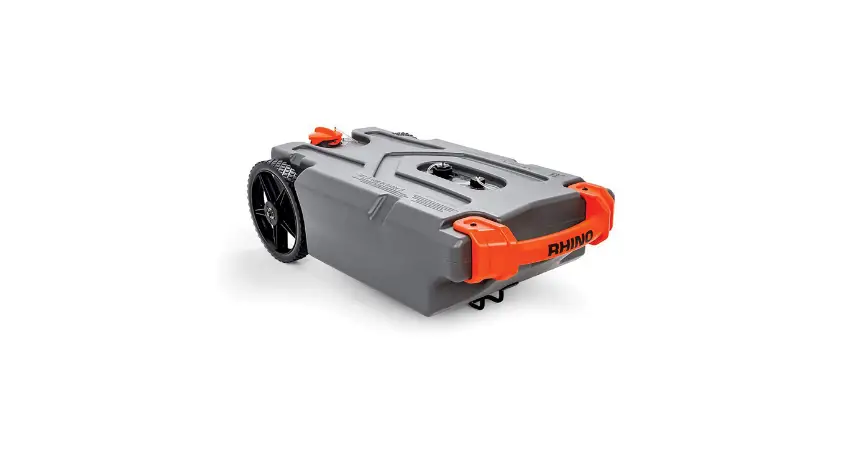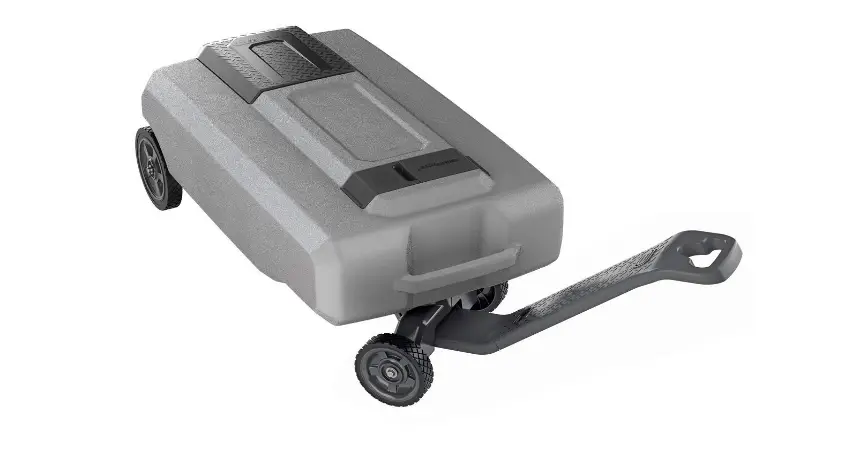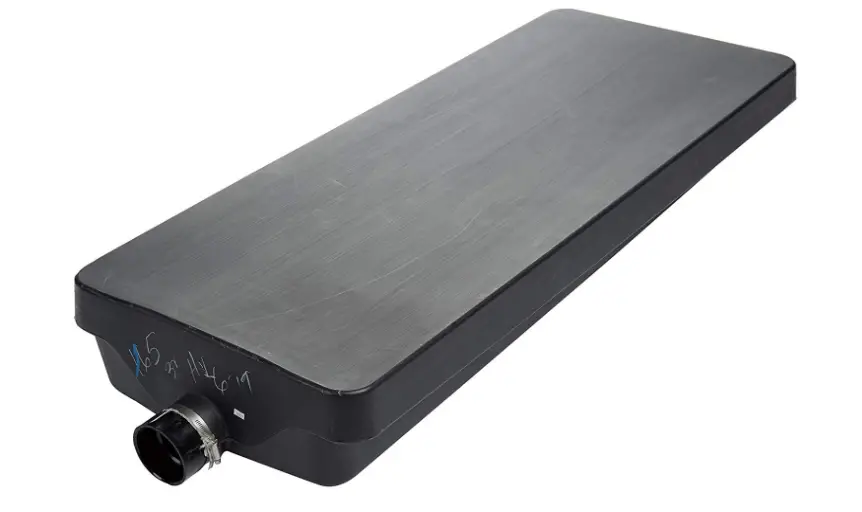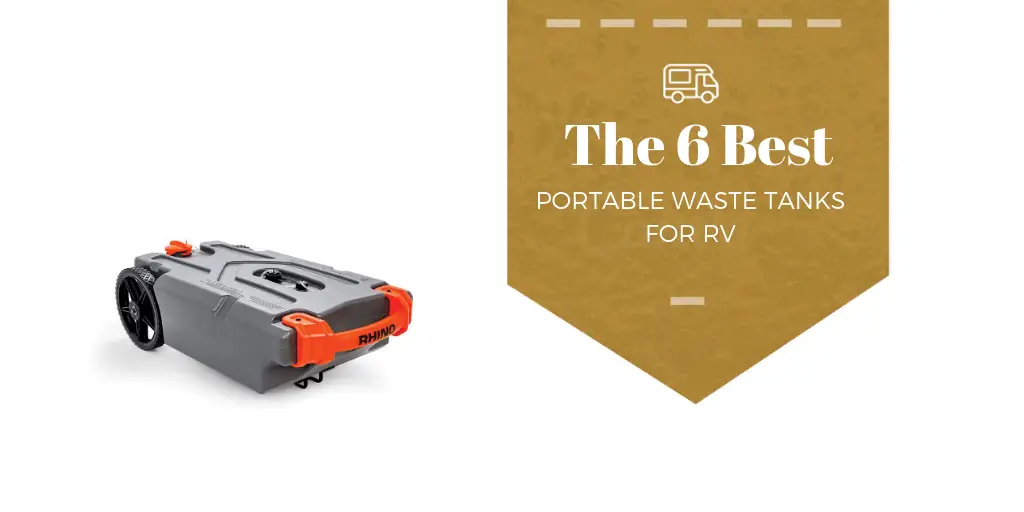
6 Best Portable Waste Tanks for RVs
If you spend a considerable amount of time in your RV, it’s inevitable that you’ll need an excellent portable waste tank. If you keep your RV parked in a campsite all the time, you probably don’t need to worry about this, unless it doesn’t have a sewer connection. However, if you actively travel, even intermittently, having a portable RV waste tank is crucial.
Furthermore, it’s essential to invest in a good waste tank. Trust me. You don’t want to cut corners where waste tanks are concerned. It can get messy, for lack of a better word.
Table of Contents
What is a Portable Waste Tank?
An RV portable waste tank is the most effective way of disposing of both gray water (shower and tap water) and black water (toilet water). An RV portable waste tank can hold both liquid and solid wastes generated in the RV. It’s attached to the RV, treated with chemicals to mitigate the odor, and allowed to fill up. Once almost full, you can tow or carry it and dump it at a dump station. It is essential for those who travel around often on their RVs.
Why Do You Need One?
The prospect of handling and dumping a waste tank isn’t pleasant. But if you’re an RV user, it’s essential for some reasons.
- Many campgrounds don’t have public bathroom facilities or sewage connections. So you have to dump your waste somewhere.
- It’s possible that you might want to use the toilet when you’re still on the road. In that case, you don’t have to wait for miles and miles, hoping for a public bathroom, and you can simply use your RV’s toilet and rest assured that you have a waste tank in place.
- When you’re using a waste tank, try to limit your water usage as much as possible to save yourself another trip to the dumping station. This automatically necessitates an economic use of water, making it an environmentally-friendly option.
- Waste tanks can be sorted into black tanks and gray tanks. You can dump out the black water and then use the gray water to clean the black tank. This makes the process a lot cleaner and more hygienic.
Best Portable Waste Tanks for Your RV
There are a lot of different RV portable waste tanks on the market, but which one is suitable for your specific needs? Over the years, I have used several waste tanks, some of which have been a godsend and some of which have led to embarrassing situations. In this article, I’ve compiled my findings to give you a detailed overview of the best RV portable waste tanks on the market.
1. Barker 30844
The Barker 30844 is undoubtedly the best 4-wheeler portable waste tank for RVs on the market. I especially love it because of its strength and durability: it’s made of blow-molded polyethylene, zinc plated steel and aluminum, and is simple to use. It has large pneumatic rubber tires that easily allow it to be towed and a 3-inch sewer valve that can be easily secured and fastened.
It also comes equipped with a full tank indicator that lets you know when the sewage tank is about to fill up. You can then shut off the valve in the holding tank in time to prevent a spill. Some tanks come with an auto shut-off feature that detects if the tank is filling up and automatically shuts it off. However, I don’t like this because if you shut off the portable tank’s valves before the holding tank’s valves, the waste will accumulate in the hose, leading to a possible rupturing or spill.
This portable waste tank is available in sizes ranging from 16 to 42 gallons. With 2-wheel waste tanks, you have to lift one end and drag the tank along the ground while its wheels barely support its weight. Furthermore, 2-wheelers can’t be drained horizontally, so you have to lift them into a vertical position.
This 4-wheeler waste tank resolves this issue because you have to hold on to the handle, and the tank rolls along the ground without any need to lift it. The wheels are air-filled, and set on axles with rear wheel bearings, so that they can be rolled along easily on even the hardest of surfaces. Trust me. Your arms will thank you for the consideration! Once you reach the dumping station, you can empty it from the horizontal position and don’t need to lift it.
While I love the wheels on this waste tank, I am not a fan of the hose. Yes, you do get a 3-foot long hose that allows you to drain the holding tank into the portable waste tank, but it’s of inferior quality and requires frustrating assembly. As you might be aware already, transference of fecal matter from the holding to the portable tank is where most leaks occur. So don’t skimp on the hose and get the very best sewer hose separately. You should ideally get a hose with a 90-degree elbow at the end, so you don’t have to contort it to fit into the valves.
Pros
- Can dump while it’s still horizontal.
- Pneumatic wheels can be used on any ground.
- Don’t have to lift it from one end, can simply roll it along.
- Full tank indicator available.
- Extremely sturdy and durable.
Cons
- The sewer hose is made of inferior quality.
2. Barker 31342
The Barker 31342 is a 2-wheeler RV portable waste tank available in capacities ranging from 10 to 30 gallons. I don’t care for 2-wheeler waste tanks for the reasons mentioned in the previous review — you need to lift one end, it’s hard to roll, and it needs to be emptied vertically. However, a lot of people don’t want to shell out the inordinately high cost of a 4-wheeler portable waste tank, so I include this for them.
The Barker 31342 is undoubtedly the best 2-wheeler RV portable waste tank on the market, especially considering it’s made of the same materials as the Barker 30844. Made of blow-molded polyethylene and quality zinc-plated steel brackets, it’s extremely durable, and you don’t need to worry about corrosion, cracks, etc.
It comes with large-heavy duty wheels. However, you’ll still have to lift it from one end, and the hind wheels only offer so much support. If you’re taking it soft ground, you’ll find that the wheels dig into the dirt, making it hard to move forward adequately. You might even have to lift the whole waste tank and carry it occasionally. Furthermore, when it’s time to dump, you have to lift it into a vertical position. If you’re getting the small 10-gallon waste tank, that might not be an issue. But, if you’re using the 30-gallon tank, well then, you have my condolences. I also found that it doesn’t empty entirely because of the design. As such, if it contains black water, you might have to remove the last bit manually.
Like the Barker 30844, this waste tank comes with a sewer hose. However, the hose suffers from the same issue. It’s not durable and exceptionally frustrating to assemble; and the end of the hose is hard to fit into the holding tank’s valves. As mentioned in my previous review, you’ll be better off purchasing a separate sewer tank altogether. The provided hose, however, can be used to connect the tank to a hose bib, so you can rinse it thoroughly with water to clean it.
A little suggestion: don’t fill it up to the brim. After remaining in the tank for a long duration, fecal matter and waste build up methane. As such, if you’ve filled it up to the top, the pressure will be strong, and it might blow the wastewater out of the top the moment you release the valves. I speak from experience. Leave a few inches of space at the top.
Pros
- Reasonably priced.
- Relatively lightweight.
- Durable construction.
Cons
- Has to be lifted from one end.
- The wheels can’t take you through soft grounds.
- Has to be drained in a vertical position.
- Due to the design, it doesn’t drain all the way through efficiently.
- Sewer hose is made of inferior quality.
3. Tote-N-Store 20123
The Tote-N-Store 20123 is a 4-wheeler portable RV waste tank available in the capacities of 18, 25 and 39 gallons. This is a great option if you, like me, don’t like 2-wheeler waste tanks but can’t afford the Barker 30844. This is a budget option. Or what can pass as a budget option considering all 4-wheeler waste tanks are incredibly overpriced.
This waste tank has narrow wheels that adequately allow you to roll it on a hard asphalt surface. However, if you try to roll it along soft ground or through gravel, the wheels might cave in or give away, putting you in a position to having to lift and carry them on your back. The wheels never entirely came off while I used them; however, I have heard complaints from several users who showed me visual evidence of how the wheels collapsed when made to roll along uneven ground. Thus, you should only purchase this waste tank if you’re sure that you’ll only need to use it on hard, even ground.
I also have an issue with the compartment door. While towing it, the door threatened to open as it’s not well fastened well. I was terrified of that happening because of the mess it would create! I had to fasten it with a bungee cord eventually, but I shouldn’t have had to do that. The door should be strong enough to hold even when towing the waste tank through rough terrain. Furthermore, the sewer hose comes with bayonet connectors on both ends, which makes it impossible to attach an elbow on one end. I had to purchase a separate sewer hose.
This is still a much better choice than a 2-wheeler waste tank because you don’t have to lift one end, nor do you have to empty it from a vertical position. I also liked that translucent drain pipes were provided. This allows you to gauge how full the tank is getting and drain the tank accordingly.
Pros
- One of the most budget-friendly 4-wheeler portable RV waste tanks.
- Can be emptied in a horizontal position.
- No need to lift it on one end.
- Translucent drain pipes allow you to see how full or empty the tank is.
- Comes with a storage compartment where you can keep the accessories.
Cons
- Wheels are narrow and small.
- Can’t be used on soft or uneven ground.
- Compartment door doesn’t close properly.
- The sewer hose can’t accommodate an elbow extension.
4. Camco Rhino 39002
The Camco Rhino 39002 is a 2-wheeler RV portable waste tank that comes in capacities ranging from 15 to 36 gallons. Even though it’s a 2-wheeler waste tank, I don’t hate it quite as much as most other 2-wheelers because the heavy-duty wheels are huge.
As such, you still have to lift them — they’re quite durable — and you can also tow them across soft or uneven ground without fear of them giving away. This makes towing the tank less strenuous, as you’re not always worried about damage and having to carry the tank. Furthermore, the handlebar at the end can be attached to the back of a golf cart or truck, and you can tow it behind slowly.
One my issues with the Barker 31342 is its design, which doesn’t allow the waste to be cleared entirely. However, the Camco Rhino 39002 is designed with a shallow drain hole, so it drains completely. Furthermore, it also comes with an integrated tank rinser that can be used to efficiently clean and rinse the interior.
The entire tank is made of blow-molded UV stabilized HDPE material. It’s adequately durable and doesn’t expand under the sun. Furthermore, the 3’ sewer hose provided has a bayonet at one end and lug fitting on the other, so you can attach an additional elbow accessory, if you so choose. This feature wasn’t even available in some of the better Barker models, so I appreciate it.
I would also caution against using the 6’ hose. They provide a 6’ hose with the larger tanks, but it’s really slippery and moves around quite a bit once you remove it from the tank. I tried using it and got gray water all over myself and some of my coworkers. So use a 3’ hose that’s a lot easier to manage. If you must use a 6’ hose, get one that’s a little stiffer than this one.
I was also disappointed to find that this unit doesn’t come with a level indicator. You have to estimate when the tank might be close to filling up. If you make the wrong guess, your waste might start leaking, or you might overfill the tank. This is quite a big oversight on the part of the manufacturer.
Pros
- The wheels are large and durable.
- Durable construction.
- Easy to drain it entirely.
Cons
- Sewer hose can be too flexible for comfort.
- No level indicator available.
5. Thetford SmartTote2 40518
The Thetford SmartTote2 40518 is a 4-wheeler RV portable waste tank with a 27-gallon capacity. It only comes in one size, so you can use it for short trips only and if you’re a single individual.
The front wheels of the tank are attached to the handle to facilitate maneuverability. The handle itself is extendable, which is great because you don’t have to slouch uncomfortably to tow it, nor do you have to use an extension. Furthermore, the extendable handle can easily be tucked under the tank when not in use, so it doesn’t take up too much space in the RV. The handle can be easily attached to the back of your RV or vehicle, so it can be towed comfortably, and you don’t have to keep it inside your RV. I also found it pretty easy to drain the tank since the port is quite large. It also has an AutoStop level gauge that prevents it from overfilling and spilling.
The only real issue here is the foldable handle and the wheels’ durability. I used it for a few weeks and it worked perfectly, and I do like the design. However, I was dubious about how long it would last with continuous folding and unfolding for several months and whether the wheels would be able to work over uneven gravel paths. So I contacted several other users and was disappointed that they all voiced a similar sentiment. Everyone who had used it for over 6 months said that either the handlebar or the wheels, or both, came apart eventually. While the same hasn’t happened to me (yet), I have to take the word of so many people.
This is a reasonable and smartly-designed waste tank. But it’s not durable, and you shouldn’t purchase it for regular or long-term use.
Pros
- Extremely reasonable for a 4-wheeler waste tank.
- Easy to maneuver.
- Draining and cleaning are easy.
- Come with an AutoStop level gauge.
- The handle can be folded under the tank.
Cons
- Not durable. Both wheels and handle can break or come apart after a few months.
6. Alpha Systems VB22548H
The Alpha Systems VB22548H is the only no-wheel RV portable waste tank on this list. In addition to not having any wheels, it’s mainly meant for gray water waste, but you can also use it as a black waste tank provided you add plenty of water to prevent possible clogging. It’s cheap, and some people need waste tanks for temporary use, so it’s ideal for them.
The tank is made of blow-molded HDPE material and is extremely tough and durable. It has a uniform thickness throughout the body which adds to the durability. Since there are no wheels attached, you cannot tow it. You will have to either lift it or carry it in a vehicle. If you need to secure it, you can use steel straps with a rubber seal so that the strap doesn’t rub through the plastic. It has a 3” outlet from which you can connect the sewer hose. The outlet is positioned such that all the waste can efficiently be released, and it’s easy to clean up after.
You can connect this waste tank to the bottom of your RV. There are many ways to accomplish this. Some people prefer to make a little cage using straps. I preferred to use the lipped edge of the tank to weld brackets for the tank to sit on. I was disappointed, however, that the manufacturer didn’t provide any tools to mount the tank or attach it to the RV. Considering that mounting is a pretty essential part of using this tank, that’s quite an oversight.
These tanks have four sensors attached — one ground sensor next to the outlet and three level sensors. These sensors can detect when the tank is filling up so you can stop.
Pros
- Durable material.
- Sensors available.
Cons
- No wheels, so it’s hard to carry.
- Has to be mounted to the RV and the manufacturer doesn’t provide any tools for it.
FAQ About Portable Waste Tanks
The different types of RV Portable Waste Tanks
There are 2 types of portable waste tanks out there- a gray and a black one.
Gray Tank
The gray tank is where all your wastewater (other than toilet water) is disposed. It collects water from the sink, shower, etc. Some RVs come with a single gray tank, whereas some come with two gray tanks, one for the bathroom and another for the kitchen. If you use separate gray tanks, you’ll have the responsibility of draining and cleaning them separately, doubling your work.
You can also leave your gray tank valve open when you’re hooked up to a sewage drain so the gray water can drain out and you don’t have to dump it later.
Black Tank
The black tank is mainly meant for toilet waste, so it’s pretty disgusting. Spills are inevitable with tanks, at least occasionally, so you’re responsible for cleaning them up when that happens.
Black tanks also clog up easier than gray tanks because they hold both solid and liquid waste. As such, solid buildup can lead to clogs which you’ll have to fix later. To avoid clogs, make sure you flush often, so there’s plenty of liquid in the tank, and avoid flushing toilet paper. If you must flush toilet paper, be sure to use those explicitly meant for RVs.
You should never leave your black tank valve open for an extended period, as all the liquid will flow out and leave behind solid waste, increasing the likelihood of a clog. Only open the valves when at the dumping station and be ready to pour out the liquids and solids.
Which Factors to Consider when Buying an RV Portable Waste Tank
There are many different factors to take into consideration when buying an RV portable waste tanks. The following are some of the most pertinent factors to consider.
Type
As mentioned above, some waste tanks can only hold gray water, some can only hold black water, and some can hold both. If you’re handling gray water, buying the wrong tank might not make a big difference. However, if you’re handling black water and buy the wrong tank, you could be in for a sticky situation. So read the product description carefully and choose wisely!
Material
RV portable waste tanks are available in different materials, but the most popular are plastic and polyethylene. Plastic is preferred over metal tanks as it’s relatively immune to corrosion and cracking. However, if you want to prevent the slightest of odor from breaking through, polyethylene will be a better choice as it has thick and impenetrable walls.
Simplicity
An RV waste tank should come with a flush valve attached to the hose and used to flush the waste easily. If the waste tank doesn’t come with this feature, you’ll either have to remove the waste manually or purchase a separate flush valve. It’s also important that you read the product’s reviews to make sure that it doesn’t clog and get messy while emptying the tank.
Portability
RV waste tanks are available with no wheels, two wheels, or four wheels. The higher the number of wheels, the more portable it is because you can simply tow it instead of carrying it. Furthermore, the wheels should be made of rubber, so it rolls easily.
Size
It’s crucial to consider how large you want your waste tank to be. You don’t want to be forced to undertake the arduous process of emptying the tank too often, and you don’t want it leaking either. The size of the tank is determined based on several factors.
- Length of Trip: The length of your trip is a big factor in how big the tank should be. Are you going to be on the road for over 3 days? If so, get a waste tank with a 30 to 42-gallon capacity. Are you going to use it for a single weekend? If so, a waste tank of less than 30 gallons should suffice.
- Number of Individuals: The number of people who will be in the RV also determines how much of the waste tank is used. If a family of four or more people will be in the RV, for even a short period, you will naturally need a large tank. But if just for yourself, you don’t need a huge waste tank.
- Size of the RV: It might be tempting to simply get the biggest waste tank possible. You’ll be sure that no matter how much waste you have in your black tank, you can always dispose of it. However, you also need to consider the size of your RV and whether the waste tank can fit into it. Furthermore, a larger waste tank is even harder to clean.
- Size of the Holding Tank: You should ideally buy a portable waste tank as spacious as your RV’s holding tank. If your black tank is 25 gallons, get a portable tank that’s also 25 gallons. As such, you’ll be able to empty the entire holding tank without spilling.
Features
Different portable RV waste tanks come with various features and accessories. Some enhance the convenience and durability of the waste tank, so study them carefully.
- Separate compartment to hold waste tank tools like hoses.
- Cradle pivots.
- Auto-stop systems.
- Tow handle extensions.
Where to Dump the Contents of the RV’s Holding Tanks?
There are three different places where you can dump the waste from your holding tanks:
- Campsites: Your gray and black water holding tanks can be connected to the camp’s sewers. However, the solid waste from the black water tank might not get adequately disposed of, which could lead to buildup and clogs.
- Dump Stations: You can drive your entire RV to the dumping station and dump your waste there. This is inconvenient because it requires you to drive your entire vehicle to the station. As such, you might lose your spot if you’re boondocking or, if at a campground, you will have to pack up your entire rig every time you go to a dump station.
- Portable Waste Tank: You can drain your holding tank into your portable waste tank and then stow it away until you get the time to go to a dump station to empty it.
How to Empty the RV Holding Tank into the Portable Waste Tank?
The scariest part of using a portable waste tank is the part where you have to drain the black and gray holding tanks into the portable waste tank. This is the moment for the maximum potential of a messy spill, so you have to be very careful.
To make sure that you don’t get messy, follow these steps carefully:
- There’s generally one outlet for the black water and the gray water. Only some RVs come with separate outlets for gray tanks. The outlet will have separate valves for the gray tank and black tanks. You can find them in your RV manual. Be sure to identify which valve is for gray water and which is for black, and be sure not to get them mixed up.
- Open the outlet’s cap. Don’t worry, unless the valves are open. No waste will come out at this point.
- Connect the sewer hose to the correct valve and the other end into the portable waste tank.
- Open the grey tank’s valve gently. If there’s a leak, at least nothing seriously nasty will seep out. Once you’ve confirmed there’s no leak, close the valve immediately. You are going to drain the black tank first.
- Open the black tank valve and allow it to drain completely.
- If you have a black tank flush, connect the hose to it and allow the flush to run into the tank for a few minutes while the black tank is open. This will ensure that everything is cleaned out properly. Once done, turn off the water and disconnect the hose.
- Firmly seal the black tank valve.
- Connect the hose to the gray tank valve. This will wash out the hose, so no fecal matter stays stuck to it.
- Close the gray tank valve as well.
- Disconnect the hose from the RV once all of it has drained into the portable waste tank. Lift it by holding the end high, so nothing drips or spills on you.
- Rinse it thoroughly with water, both inside and out.
- Disconnect the hose from the portable waste tank. Rinse it again.
- Shut off the portable waste water’s valve.
- Put the cap back on the RV’s outlet and close both levers, so there’s no leakage.
- Keep your sewer hose back in storage.
- Carry the portable waste tank to the nearest dumping station and empty its contents.
- Clean the waste tank thoroughly and make sure there’s no matter still inside.
How to Clean a Portable RV Waste Tank?
- Add bleach and water to the RV’s holding tank only if it’s empty and clean.
- Run water through the tank till the bleach gets mixed in and completely dissolved.
- Allow the bleach to sit in the tank for a day.
- Drain the bleach water into the portable RV waste tank.
- Add treatment chemicals to dissipate the smell of the waste.
- Allow the bleach water to sit in the portable waste tank.
- Drain the portable waste tank and rinse clean with water.
- Keep the tank open till the smell of bleach is gone.
How to Avoid Clogging?
Are you afraid of your black tank clogging up? Are you apprehensive about having to dump your tank way too often? The solution is simple.
Don’t EVER dispose of toilet paper, feminine hygiene products, or other solid waste in the toilet. Dispose of them in a bin with a lid. This will drastically reduce the likelihood of the black tank clogging. It will also allow you to purchase the type of toilet paper you want without having to worry about the brand.
Furthermore, solid waste take up a lot of space in the black tank. If you dispose of it in the bin, you’ll save a lot of space and be taking trips to the dumping station far less often. This is fortunate, especially if you’re boondocking because you’ll be able to stay in the campground for longer periods before needing a trip to the dumping station.
Conclusion
I hope this article has helped you select the best RV portable waste tank for your needs. Use it carefully, follow all sanitary and safety advice, and drive around your RV without fear of a sewage outbreak



